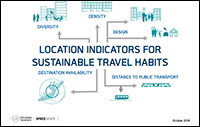Publikation
Location indicators for sustainable travel habits
To attain Sweden's environmental goals, 2010 levels of emissions from national transport must be decreased by 70 percent before 2030. New fuels and vehicles must be developed together with a comprehensive switch from energy-intensive modes of transport to more energy-efficient ones.
93 percent of emissions in 2017 came from road traffic. There is a broad consensus in the research world on the central role urban development plays in travel habits and motor vehicle ownership. These relationships have been studied in several major meta analyses, both globally and in a Nordic context.
A categorisation that is commonly used of what affects travel habits is called the “5 Ds“ (Distance to fast public transport, Density, Diversity, Destination availability and Design).
Seven recommendations
Developed location indicators and models can be used in the next step to model travel habits given different expansion policies and to calculate CO2 emissions from transport. In order to reduce emissions from passenger transport by means of urban planning, the following seven recommendations have been compiled.
- Prioritise expansion near the regional centre
- Prioritise expansion within 1 km from rail station or express bus stop with high frequency service.
- Construct residences where there are premises and construct premises where there are residences
- Transform roads into streets
- Limit the proportion of single-family houses
- Increase the service frequency of express buses in suitable station communities
IN SHORT
Authors
Per Kristersson, Göteborgsregionen. Tobias Nordström, Staffan Swartz and Oskar Sirland, Spacescape. Anna Clark, Trivector.
Year of publication
2019
Developed in project
The “Regional Analysis“ research project

Uppdaterad




